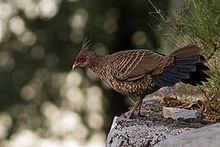| Kalij pheasant | |
|---|---|

| |
| Male L. leucomelanos hamiltoni, Uttarakhand, India | |

| |
| Female L. leucomelanos hamiltoni, Uttarakhand, India | |
| Scientific classification | |
| Domain: | Eukaryota |
| Kingdom: | Animalia |
| Phylum: | Chordata |
| Class: | Aves |
| Order: | Galliformes |
| Family: | Phasianidae |
| Genus: | Lophura |
| Species: | L. leucomelanos
|
| Binomial name | |
| Lophura leucomelanos (Latham, 1790)
| |
The kalij pheasant (Lophura leucomelanos), or simply kalij, is a pheasant found in forests and thickets, especially in the Himalayan foothills, from Nepal, Pakistan to western Thailand. Males are rather variable depending on the subspecies involved, but all have at least partially glossy bluish-black plumage, while females are overall brownish. Both sexes have a bare red face and greyish legs (the latter separating it from the red-legged silver pheasant).[2] It is generally common and widespread, though three of its eastern subspecies (L. l. oatesi, L. l. lineata, and L. l. crawfurdi) are considered threatened and L. l. moffitti is virtually unknown in the wild.[2] On 21 October 2021, the Government of Jammu and Kashmir declared Kalij Pheasant as bird of the Union Territory of Jammu and Kashmir.[3]
The name is also spelled kaleege in old texts, such as Game Birds of India and Asia by Frank Finn,[4] though no longer in his Indian Sporting Birds.[5] The species was introduced to Hawaii[1] in 1962 as a gamebird.[6]
- ^ a b BirdLife International (2016). "Lophura leucomelanos". IUCN Red List of Threatened Species. 2016: e.T22679217A92807873. doi:10.2305/IUCN.UK.2016-3.RLTS.T22679217A92807873.en. Retrieved 12 November 2021.
- ^ a b McGowan, P. J. K. (1994). Kalij Pheasant (Lophura leucomelanos). pp. 533 in: del Hoyo, J, A. Elliott, & J. Sargatal (1994). Handbook of the Birds of the World. Vol. 2. New World Vultures to Guineafowl. Lynx Edicions. ISBN 84-87334-15-6
- ^ "Kalij Pheasant declared as bird of Jammu & Kashmir UT". The Chenab Times. 21 October 2021. Retrieved 21 October 2021.
- ^ Finn, F. (1911?). Game Birds of India and Asia.
- ^ Finn, F. (1915). Indian Sporting Birds.
- ^ "Lophura leucomelanos | Kalij pheasant". hawaiibirdingtrails.hawaii.gov. State of Hawaii. Retrieved 25 February 2018.
